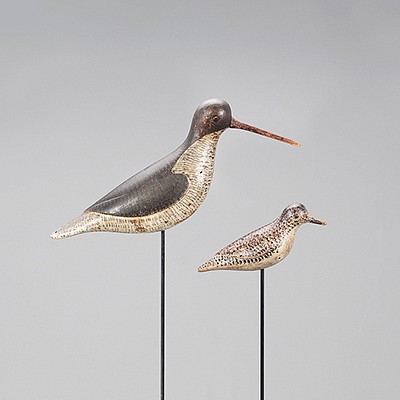Early and Important Mallard Drake Decoy, Henry Ruggles (1830-1897)
About Seller
20 Winter Street
Pembroke, MA 02359
United States
Founded in 2005, Copley Fine Art Auctions is a boutique auction house specializing in antique decoys and American, sporting, and wildlife paintings. Over the course of the last two decades, the firm has set auction records for not only individual decoy makers, but also entire carving regions. Copley...Read more
Two ways to bid:
- Leave a max absentee bid and the platform will bid on your behalf up to your maximum bid during the live auction.
- Bid live during the auction and your bids will be submitted real-time to the auctioneer.
Bid Increments
| Price | Bid Increment |
|---|---|
| $0 | $50 |
| $1,000 | $100 |
| $2,500 | $250 |
| $5,000 | $500 |
| $10,000 | $1,000 |
| $25,000 | $2,500 |
| $50,000 | $5,000 |
About Auction
Jul 10, 2021
Lots 247-507 Copley Fine Art Auctions cinnie@copleyart.com
- Lot Description
Early and Important Mallard Drake
Henry Ruggles (1830-1897)
Henry, IL, c. 1870
17 in. long
"One of the earliest decoy carvers in the Illinois River Valley, Henry Ruggles created very fine and distinctive birds. Very few of his decoys have survived and been found, a fact that has limited recognition of his name. His style, however, influenced a generation of carvers, including Charles Perdew. Finding any Ruggles' decoys in original paint has proven difficult for collectors, making this prime mallard example all the more desirable." -Stephen B. O"Brien Jr. and Julie Carlson, "Masterworks of the Illinois River"
Finding any Ruggles' decoys in original paint has proven difficult for collectors, making this prime mallard example a highly collectible Illinois River masterwork.
An apprentice studio painter in St. Louis, Missouri, Ruggles was a talented portraiture and landscape artist. In Henry, he was also noted locally as a musician; in the summer months, he played violin, mandolin, and guitar for the pleasure of family and friends.
Hunting and fishing were Ruggles' true passions. To aid in his success in luring waterfowl, he carved graceful birds with sleek bodies and elongated heads. Ruggles fashioned hollow, feather-weight decoys that were wide bodied in comparison to other Illinois decoys. Another recognizable Ruggles carving trait is the unusual squared tail with which he finished his decoys, as seen on this mallard. His painting style was well honed with bold, sure-handed brush strokes.
Several Ruggles and Robert Elliston decoys migrated north to Wisconsin where affluent Chicago hunters brought them to the prestigious Nee-Pee-Nauk Club. Organized by A. H. Sellers in 1882 and situated by the Horicon Marsh, the Ne-Pee-Nauk Club is on some of the best hunting grounds in Wisconsin. The club boasted a distinguished membership, including Civil War General Philip Sheridan (1831-1888) along with numerous Chicago congressmen and doctors who would venture by train up from the city. The club has remained in continuous operation for nearly 140 years and is the oldest active duck club in Wisconsin.
The underside of this early mallard drake is branded "DENTON" and "MORRIS SELLERS" and the lead-strip weight is embossed "CHICAGO ILL."
In original paint with even gunning wear, including a minor chip on left side of neck seam.
Provenance: Morris Sellers and Denton Rigs
Herb Wetanson Collection
Literature: Stephen B. O'Brien Jr. and Julie Carlson, "Masterworks of the Illinois River," Boston, MA, 2005, p. 21, similar decoy illustrated. Gene and Linda Kangas, "Decoys: A North American Survey," Spanish Fork, UT, 1983, p. 245, pl. 374, related mallard illustrated. Joe Engers ed., "The Great Book of Wildfowl Decoys," San Diego, CA, 1990, p. 228, related example illustrated.Please email condition report requests to colin@copleyart.com. Any condition statement given is a courtesy to customers, Copley will not be held responsible for any errors or omissions. The absence of a condition statement does not imply that the lot is in perfect condition.Condition
- Shipping Info
-
Copley Fine Art Auctions does not handle the shipping of any items. Shipping is the sole responsibility of the buyer. Once your payment has cleared, and we have received your authorized shipping release form items may be released for shipment. Copley Fine Art Auctions, LLC shall have no liability for any loss or damage to such items. Buyers should allow up to four weeks for shipment. Please be aware that internet bidders may NOT not pick up their items at the sale. Items will be available for pick up by appointment or by shippers five days after the sale.
-



 EUR
EUR CAD
CAD AUD
AUD GBP
GBP MXN
MXN HKD
HKD CNY
CNY MYR
MYR SEK
SEK SGD
SGD CHF
CHF THB
THB














